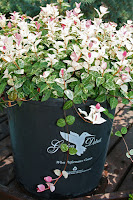 |
| Snow N Summer® Asiatic Jasmine |
A colorful palette of ground covers adds an extra dimension to the lower levels of my landscape. These ground-hugging plants that spread widely yet remain short and close to the ground have a new look these days with a selection of foliage colors. Brightening up sunny spots as well as shade, many choices of perennial ground covers are available for the artistic gardener and landscaper. Ground covers protect the soil from erosion and drought, while providing a flat layer of vegetation beneath the shrub layer.
Pink
and White
Trachelospermum
asiaticum Snow N Summer® Asiatic Jasmine by Garden Debut®. The amazing pink
foliage color of looks like flowers in the bed but is adaptable and evergreen,
making it an excellent mounding 12-iinch ground cover that spreads to three
feet. New foliage emerges striking pink, turning to clear white, then to
variegated white and emerald green on older foliage.
Mahogany-Red
Bronze
Ajuga reptens Bronze has appealing dark mahogany-maroon foliage that thrives in sun or shade and reaches 6 to 10 inches in height and spreads by runners. Short spikes of attractive blue flowers cover the mat in spring, attracting bees and butterflies.
Ajuga reptens Bronze has appealing dark mahogany-maroon foliage that thrives in sun or shade and reaches 6 to 10 inches in height and spreads by runners. Short spikes of attractive blue flowers cover the mat in spring, attracting bees and butterflies.
 |
| Angelina Sedum |
Brilliant
Yellow
Sedum
rupestre Angelina- the brilliant-yellow spreading fleshy foliage of this
succulent ground cover turns orange at the tips in autumn. It’s only 3 inches
tall but spreads to two feet wide and more in sun.
Yellow
and Green
Vinca
minor ‘Sunny Skies’ PP13466 features yellow variegated leaves and bright blue springtime
flowers, attaining about 12 inches in height and spreading to two feet.
 |
| Bunny Blue Sedge |
Silvery
Blue
Carex
laxiculmus Bunny Blue Sedge Grass by Garden Debut® is a grass-like ornamental
groundcover with narrow foliage and year-round interest. Aqua-silvery blue leaves
to 12 inches tall will spread to a large, dense clump.
There
are many other ground covers that increase the gardener’s color choices. Have
you tried some of these? What is your favorite?





















